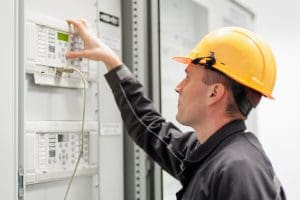Sometimes we’re a little too close for comfort.
As we’ve all learned in the last year, sometimes a little social distancing gives a lot of protection. The same goes for your relationship with your electrical installations.
Electrical equipment injuries represent a serious workplace health and safety issue. There are thousands of electrical accidents each year – including 5 to 10 arc flash incidents per day in the U.S. These are devastating to workers’ health, and also expensive for companies. According to OSHA, medical care for arc flash injuries can cost over $1 million, in addition to expensive equipment damage, power outages, and potential regulatory fines if safety protocols haven’t been followed.
When you can interact with electrical equipment from a distance, you mitigate safety hazards like arc flash.
Have a conversation with your equipment, just not right next to it.
You don’t need to stand next to your equipment to hear what it has to say. Using connected equipment and digital tools, you can monitor nearby equipment from a safer distance.
Digital tools like apps use real-time data about equipment health and performance, which is collected from sensors located on the connected equipment. Apps harness these sensor data and show remote operators a comprehensive, real-time visual picture of a substation, inside and out. Field personnel can use this technology to virtually inspect live nearby equipment from a comfortably safe distance and save time across the equipment assessment process.
Don’t just chat, get some work done.
It’s not only about monitoring, it’s about control. Digital tools and apps like EcoStruxure Power Device let your field crews put some distance between themselves and the equipment they need to work on. This means field technicians can stay up to 10 meters/33 feet away from the live equipment and operate it by using the app on their tablet or phone with no physical interaction.
Field crews are no strangers to face masks, as working with live equipment already needs significant protective equipment, including shields. So, performing the same operations from a nearby distance can become the new normal.
This helps reduce the arc flash hazard during circuit breaker racking, for example. These sometimes occur when withdrawable components such as circuit breakers and voltage transformers are inserted or withdrawn from equipment, otherwise known as “racked” in or out. By using an integrated remote racking system instead, operators can rack in or out equipment while standing outside the arc-flash boundary. Remote control also reduces workers’ exposure to hazards when conducting operations that require access when repairing or monitoring equipment.
To see how digital tools and apps for nearby monitoring and control increase safety and efficiency, take the example of a typical thermal inspection. Field crews can perform a thermal inspection on electrical distribution from a safer, nearby distance thanks to wireless thermal sensors that feed their measurements to an app on a field technician’s tablet. The technician sees real-time information about temperature, including abnormal temperature rises that could potentially lead to arc flash or fire hazards. The technician can then use the same smartphone app to remotely operate the equipment from a nearby distance – all without requiring manual intervention or substation shutdown.
And improve efficiency while you’re at it.
The sensors that make nearby monitoring and control possible can also unlock a host of other benefits beyond safety. For example, facility managers or third-party maintenance companies can use nearby apps for added efficiency, cost savings, value, and convenience.
24/7 connected architectures reduce the time spent on operations and maintenance. Instead of monitoring equipment on-site based on a pre-determined maintenance schedule, field crews rely on smartphone alerts that immediately let them know when equipment requires maintenance. This lets the crews monitor and control assets remotely – saving companies time and money. For example, panel builders can use an app to increase remote visibility into assets so they can monitor equipment without even leaving their desk, while the apps also add value by opening up opportunities to provide more services for customers.
In general, better maintenance keeps equipment healthier, which boosts safety by reducing the overall need for equipment contact in the first place. It also increases operator safety by eliminating unplanned downtime, which may require rushed repairs that sometimes lead to unsafe decision-making or safety hazards if operators fail to follow normal operating procedures, like a rushed lockout-tagout procedure.
Don’t be shy, share.
The tools that enable nearby monitoring and control don’t live alone in a vacuum. And neither does the data that feeds them. They belong to an architecture and a suite of digital tools that can span a company’s operations across the complete lifecycle to meet their exact needs – whether that’s improved collaboration, increased productivity, safer operations, or improved equipment health. System integrators, for instance, benefit from safer installations and commissioning while also improving building and testing.
For example, the Easergy Thermal Connect app not only reduces operational hazards with connectivity, but also uses the sensor data it receives to produce shareable reports. These can be loaded onto the equipment’s digital logbook, which provides a collaborative ecosystem that keeps project documentation and information in a secure location for all stakeholders. Paperless and digital, the information is easy to locate within a secure cloud uniquely linked to the switchboard ID This trusted, connected repository leads to better asset management, including remote assistance and other services that ensure maximum equipment performance.
See how it works
Nearby monitoring and control is good news for operators and field personnel everywhere. Learn more on our website.
But it goes even further than that. Digital tools not only extend the distance between operators and equipment, but they can also be used to reduce human error, one of the leading causes of arc flash. For example, digital tools like augmented operator give workers a tablet-driven, data-overlay view of machines’ inner workings, such as an electrical cabinet or machine, instead of looking inside live equipment. Augmented reality is also being used for training workers to avoid potentially dangerous actions.




